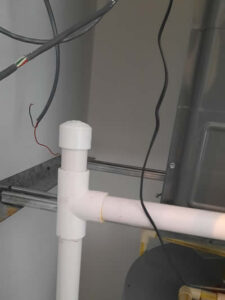 AC Drain Line Problems Solved!
AC Drain Line Problems Solved!
Having issues with your air conditioner drain line? Don’t worry – you’re not alone. A clogged AC drain line is a common issue, especially in the summer months when humidity and runoff can cause blockages. But have no fear! It’s actually quite easy to flush out a clogged AC drain line, and just requires a few simple steps.
Locate The Condenser Unit
First off, you’ll need to locate your AC’s outdoor condenser unit – this is where the drain line will be located. Once you’ve found it, obtain some food-grade (or potable) bleach so that you can flush out the drainage system. Generally speaking one quart of bleach should do the trick – but if yours requires more feel free to use more depending on what size your unit is (just make sure not to overfill!).
Condensate Pan
Next up, remove the condensate pan from beneath the unit and pour one quart of food grade bleach into it. Now turn up fan speed on your thermostat at least two Notches higher than normal for 10 minutes and allow time for unit to fill with water from below with bleach in water pipe. Once that’s done – turn off power at breaker box so compressor does not kick on & run until all residual liquid has been drained from condensate lines/pan/etc.. Wait 15 minutes for a full ac drain evacuation effect before reactivating power back at breaker box & allowing normal functionality operation again through thermostat settings.
Twice Per Season AC Maintenance
Repeat cycle twice per season or as needed when fungi or other residue appears along access panels. Lastly you may need to cover up & top off any gaps present near outdoor access caps so no debris enters during future cleaning operations = helping keep everything running smoothly while preventing unnecessary repairs down road = cost effective maintenance everyone should think about!
Once your condensate pan has been filled with bleach, it’s time to locate the clog itself in order get it flushed out properly. This could be achieved using an old garden hose attached directly onto an outside tap (with hot water), or by using an electric pressure washer wand if available – be sure cover yourself appropriately during this process as there will likely be hot steam released during use of either method!
The idea here is to put enough pressure behind flushing mechanism so as dissolve blockage & wash away anything lingering inside accessible areas simultaneously while keeping risk safe minimal exposure hazardous environments low / under control thanks proactive approach beforehand mentioned above;))))). Keep repeating cycle until any sign residue H2O drainage begins draining away properly then disconnect wand(s) & shutoff outside power sources once completed task successfully accomplished! Congrats;)))))) !



 AC Drain Line Problems Solved!
AC Drain Line Problems Solved!